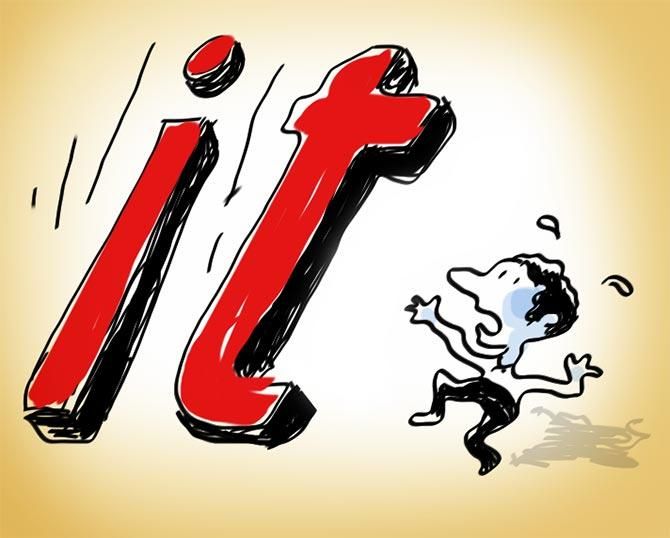‘The pressure on relative performance and the feeling of being left out among many investors may also account for the belief among many that this has to be a technology stock bubble.’
‘The feeling of a bubble is also reinforced by the extreme performance gap between growth and value investing.’
‘While at first glance, one can only stand back awestruck by the wealth creation delivered by technology stocks globally. It does not seem at all like the internet bubble of 1999-2000, says Akash Prakash.
Illustration: Dominic Xavier/Rediff.com

One of the main points of difference between bulls and bears today is whether technology stocks are in a bubble, in the US for sure and even globally.
At first glance, it does seem like there is excess in tech land. The top seven companies globally by market capitalisation are all technology companies.
The top 10 spenders globally on research & development (R&D) and capital spending combined are again all technology companies.
The top five technology companies in the US (Apple, Amazon, Microsoft, Google and Facebook, known collectively as FAAGM) have a combined market capitalisation of $3.8 trillion.
Just for context, this is a trillion dollars more market capitalisation than the top 50 European Union companies comprising the Euro Stoxx 50.
Their market capitalisation is equal to the gross domestic product (GDP) of Germany.
The top three technology companies (Apple, Amazon and Microsoft) have a market capitalisation of $2.5 trillion, greater than the GDP of India. So obviously you have huge market capitalisation and scale.
The tech companies now account for nearly 30 per cent of the S&P 500 (including Amazon as a technology company) and more than 40 per cent of the MSCI (Morgan Stanley Capital International) China index.
Even more astonishing is the relative performance of tech versus the rest of the market.
If we look at the FAAMG stocks, they are up nearly 10 times since the financial crisis.
The S&P 500 (excluding these five stocks) has slightly more than doubled in the same time frame.
The gap is even more pronounced in Asia. If we look at the top five Asian technology companies (Samsung Electronics, Tencent, Taiwan Semiconductor Manufacturing Company, Alibaba and Baidu), they are up 12 times since 2009, compared to MSCI Asia (excluding these five stocks), which has once again just about doubled in the same time period.
Basically, it was impossible to outperform your benchmark in these markets if you did not own these technology giants.
The pressure on relative performance and the feeling of being left out among many investors may also account for the belief among many that this has to be a technology stock bubble.
The feeling of a bubble is also reinforced by the extreme performance gap between growth and value investing.
Many market players draw parallels between today and the internet bubble of March 2000, or the Nifty Fifty bubble of the early 1970s.
Given the extreme positive sentiment towards technology, the relative performance and the huge scale of market capitalisation creation, this must be a bubble, right?
Let’s compare and contrast these different market environments.
First of all, today, despite their huge outperformance, tech stocks in the US are much cheaper than in the heyday of the internet bubble or the go-go days of the Nifty Fifty stocks.
If you look at the top five technology companies today, they trade at 22 times one year forward earnings (skewed by Amazon trading at 85 times earnings). A premium to the broad market but nothing dramatic.
At the height of the internet bubble in March 2000, the top five companies traded at 55 times forward earnings (Cisco and Oracle were trading at over 100 times earnings).
In the Nifty Fifty episode, the top five stocks traded at 36 times forward earnings (led by Kodak and Xerox trading at over 45 times).
It is also a fact that adjusted for earnings growth, the tech titans today are trading exactly in line with the broad market.
The favourite metric of growth investors, the PEG (price/earnings to growth) ratio of technology stocks is exactly in line with the broad market.
Even on other metrics, be it margins, cash flow generation or revenue growth, technology leaders stand out.
They generate more cash, have top line growth of 20 per cent and net margins of 20 per cent. The broad market has top line growth of sub-five per cent and net margins under 10 per cent.
Whichever way you look at it, the technology leaders of today are superb businesses and deserve to trade at the premium they do.
This is no valuation based on eyeballs, or bust business models getting valued on hope and hype.
The fundamental underpinnings of these businesses look far better than what we saw during the internet bubble.
Another factor worth thinking about is that despite the huge outperformance these stocks have delivered, the vast majority of their price appreciation has come from earnings growth and not multiple expansion.
Goldman Sachs has calculated that since December 2008, 87 per cent of the price appreciation of technology stocks globally has come from earnings growth and only 13 per cent from multiple expansion.
There has been more valuation expansion for the non-technology stocks. The technology pack is simply tracking their very strong earnings momentum.
Also as pointed out by Goldman, while Apple is about 4 per cent of the S&P 500 by market capitalisation today, this is by no means unprecedented.
If you look at history, General Motors at one point was nearly 10 per cent of the S&P 500, AT&T peaked at 6 per cent, IBM was over 7 per cent in the early 1970s, and both ExxonMobil and Microsoft have been at 5 per cent in the past 20 years.
Even on a sectoral basis at 25 per cent, the weight of the technology sector in the S&P 500 is not unprecedented.
At various points in time, the leading sector of the day, be it financials (pre-financial crisis), transports or energy, they have had similar index weights, if not higher.
While at first glance, one can only stand back awestruck by the wealth creation delivered by technology stocks globally. It does not seem at all like the internet bubble of 1999-2000.
These stocks have much stronger fundamental underpinnings. Valuations on an absolute basis do not look out of line.
They are superb businesses with strong network effects, huge addressable markets, deliver great return on invested capital (ROIC) and growth and are very well managed. They are also mostly in the winner-takes-all markets.
This is not to say that there is no risk to these stocks. Regulation is obviously the biggest.
Will regulators just decide that they are too big and powerful? Can they be broken up, or forced to change their business model in ways that harm their economics?
Given the pace of disruption, these companies are now the incumbents. Can their business model be disrupted, just like they disrupted the prior incumbent?
They are also now over owned. Given their relative performance, every investor has been forced to buy into these names. At the first sign of risk aversion, will we see profit booking?
These stocks are also long duration growth assets. As rates rise they will come under pressure.
These stocks have probably delivered peak alpha. They will probably not keep outperforming to this extent as some of the fears above take hold.
However, that is very different from saying we are in a technology bubble. More muted outperformance going forward? Yes. A bubble burst? I don’t think so.
Akash Prakash is with Amansa Capital.











